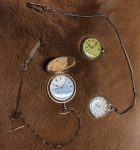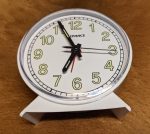When the grid goes down, some means of keeping time may be helpful. This is true not only in relation to practical details like communications schedules or food preparation. Timekeeping also contributes to emotional well-being by helping to maintain orientation in the midst of a confusing situation. This emotional benefit is so significant that interrogators often try to deprive their subjects of this benefit by restricting their access to timekeeping devices and cues.
With that in mind, I would like to talk about some non-electrical timekeeping devices that have been helpful to me, and that are ready for my use in a grid-down situation.
An Introductory Proviso
Some of the information contained in this article may be deeply disturbing to clock and watch repair professionals, clock and watch afficionados, and other people of good taste, good sense, and good will. This information should be understood as a factual report of past events, however disturbing they may be, rather than as an endorsement of those events.
I invite those with the appropriate knowledge and skills to submit an article or articles about “Clock and Watch Care for TEOTWAWKI”.
My Inherited Pocket Watches
 I have inherited three pocket watches from older relatives. I will call these the “Elegant Elgin”, the “Respectable Elgin”, and the “Workhorse Valiant”. The Elegant Elgin is a substantial and beautifully decorated, gold-plated watch with a sub-seconds placement of the second hand. Based upon its serial number, it was manufactured in 1901. When I first received it, it would not run for more than an hour or two even when fully wound. I should have taken it to a competent professional to be cleaned and lubricated. Instead, I committed an act that I now know to be sacrilege: I opened the back of the case and sprayed in some WD-40.
I have inherited three pocket watches from older relatives. I will call these the “Elegant Elgin”, the “Respectable Elgin”, and the “Workhorse Valiant”. The Elegant Elgin is a substantial and beautifully decorated, gold-plated watch with a sub-seconds placement of the second hand. Based upon its serial number, it was manufactured in 1901. When I first received it, it would not run for more than an hour or two even when fully wound. I should have taken it to a competent professional to be cleaned and lubricated. Instead, I committed an act that I now know to be sacrilege: I opened the back of the case and sprayed in some WD-40.
Using WD-40 on a watch is considered anathema for several reasons. First of all, if the watch is subsequently cleaned by a professional, the WD-40 will contaminate the expensive solution in their ultrasonic cleaner, making it necessary to replace the solution. Secondly, WD-40 is not really a lubricant. It may remove necessary lubricant from vital parts of the watch’s movement, subjecting them to unusual wear and tear. Thirdly, the WD-40 may become gummy at some point in the future, clogging the movement. Finally, excess WD-40 may leak onto the face of the watch, staining it.
I committed this act in ignorance. When I became aware of the error of my ways, as a responsible watch owner I should have repented, and immediately taken the watch to a competent professional for appropriate remedial care. Instead, I did nothing. Several years have since passed, and the watch continues to run beautifully.
The Respectable Elgin is another beautiful piece. It is an open-face watch with a sub-seconds placement of the second hand. It is also gold plated, through smaller, and much less elaborately decorated than the Elegant Elgin.
When I first received this watch it did not run at all, so I largely ignored it for a number of years. As I began to write this article, I took another look at it. I removed the back, and wound it fully. Nothing happened.
It is said that to a man with a hammer, everything looks like a nail. I have a gun cleaning kit. I gave the watch a spray of Hoppe’s 9 Lubricating Oil and removed the excess with a cotton swab. Then I replaced the back. The watch is now running beautifully.
The Workhorse Valiant is a small, open-face, stainless-steel watch with the date “October 29, 1959″ printed on the face. I believe it to be a modest retirement gift. It has no second hand. I have never given this watch any attention, because it has always run flawlessly. I imagine that the simple design and small number of moving parts make it more reliable than some more elaborate watches.
These watches usually enjoy a place of quiet rest in my “treasure chest”. In the event of an extended grid-down situation, they could be pressed into daily use.
The Elgin 31 Day Regulator Wall Clock
 This useful clock looks like a relic of a bygone age: perhaps something that you might find on the wall of a train station in the old West. I picked it up at a thrift store for $15. One great advantage of this clock is it only needs to be wound once a month. Another is that a regulator nut on the pendulum allows tiny adjustments to be made to the period of the pendulum. This makes the clock capable of keeping extremely accurate time. This clock graces the wall of our living room, where it is in daily use. I no longer wind the chimes, since they disturb my wife’s sleep at night. In order to prevent accidental winding, I have put a plastic cap over the place where the key is inserted for the chimes. A month of listening to unwanted chimes every 15 minutes does not contribute to domestic harmony.
This useful clock looks like a relic of a bygone age: perhaps something that you might find on the wall of a train station in the old West. I picked it up at a thrift store for $15. One great advantage of this clock is it only needs to be wound once a month. Another is that a regulator nut on the pendulum allows tiny adjustments to be made to the period of the pendulum. This makes the clock capable of keeping extremely accurate time. This clock graces the wall of our living room, where it is in daily use. I no longer wind the chimes, since they disturb my wife’s sleep at night. In order to prevent accidental winding, I have put a plastic cap over the place where the key is inserted for the chimes. A month of listening to unwanted chimes every 15 minutes does not contribute to domestic harmony.
About a year after I got the clock, the interval between windings began to shorten. First it would run down after 28 days, then 21, then 14. I felt more comfortable working on a larger clock than a smaller watch, so after some research online I disassembled the clock enough to give me free access to the movement. I found that the pivot points had become very gummy and dirty. I cleaned the pivot points with a toothpick, and then re-lubricated them.
I had read enough by this point to know that I should never under any circumstances use WD-40 on a clock, even as a temporary stopgap measure. Instead, I re-lubed the pivot points with a tiny amount of sewing machine oil.
The sewing machine oil worked for about a year. Then the interval between windings began to shorten again. The sewing machine oil did not leave any gummy residue, so little cleaning was necessary, but it did not have the necessary staying power.
Next I tried Otis Dry Lube. It was even less effective than sewing machine oil, lasting only about six months. I have also been dissatisfied using Dry Lube on my guns. The “Dry” part of the name seems accurate, but the “Lube” portion of the name seems to be a wild exaggeration.
Most recently, I lubricated the clock with a mixture of TW25B Gun Grease and CLP. I used the CLP to make the grease fluid enough to penetrate the pivot points. I have been extremely pleased with the results. The clock has been running as smooth as butter for more than a year.
Seiko 5 Automatic Watch
 The Seiko 5 is an “automatic” or “self-winding” watch. It harnesses the energy of the users’ motion to keep the watch wound. I must admit that I am hard on watches. I always seem to be banging my wrist on something or other, getting the watch wet, or scratching the crystal. I finally started buying the cheapest watches I could find, since they seemed to last just as long as the more expensive models. The problem was that the batteries in the cheap watches lasted for only about a year, and it typically cost almost as much to get the battery replaced as it cost to buy the watch in the first place. I finally decided to give a Seiko 5 a try, just so that I would not have to keep buying batteries.
The Seiko 5 is an “automatic” or “self-winding” watch. It harnesses the energy of the users’ motion to keep the watch wound. I must admit that I am hard on watches. I always seem to be banging my wrist on something or other, getting the watch wet, or scratching the crystal. I finally started buying the cheapest watches I could find, since they seemed to last just as long as the more expensive models. The problem was that the batteries in the cheap watches lasted for only about a year, and it typically cost almost as much to get the battery replaced as it cost to buy the watch in the first place. I finally decided to give a Seiko 5 a try, just so that I would not have to keep buying batteries.
My first Seiko 5 lasted me a little more than five years. After that time it started to run down at night while it was sitting on my dresser. It is possible that a professional cleaning and lubrication would have had it going again. The price that I was quoted for that work was more expensive than a new Seiko 5. Since I tend to have ten thumbs, I did not dare to attempt the work myself.
I had been pleased with the Seiko 5. It had seemed to hold up better than comparably priced quartz watches. I decided to replace it with another. The second Seiko 5 has lasted me almost four years so far. It is still running well after much use and abuse. I am very pleased with it.
When I began writing this article, I thought that I should probably try to clean and lubricate my first Seiko 5, just to see if I could develop any skill in that area.
I downloaded the technical guide for the Seiko 5. I discovered that it recommended three different types of oil, to be applied to 25 different lube points. I was suitably intimidated. But since the watch wasn’t working at all, I decided that I did not have anything to lose, so I might as well give it a try.
The first challenge was to remove the back of the watch. I released one end of the band using my Swiss Army knife, and then used my Leatherman Skeletool to unscrew the back. Next, I used a cotton swab with a drop of CLP to remove the dirt that had accumulated around the back, and dried it with a clean cotton swab.
The sight of all the tiny parts inside the watch weakened my resolve. I thought that I might be able to take the watch apart, but I was reasonably certain that I would never be able to get it back together. Instead I put a drop of CLP on the concave bottom of a glass, and used a brass dental pick from my gun cleaning kit to put a small amount of oil by the few lubrication points that I could reach without disassembling the watch. This effort accomplished absolutely nothing toward the goal of making the watch run again.
Finally, in desperation, I tried a squirt of Hoppe’s 9 Lubricating Oil, and wiped away the excess with a cotton swab. This did not work either. The experiment was a total failure. The watch is still totally inoperative. Maybe someday I will be brave enough to make another try. Until then, the watch will slumber quietly in the treasure chest.
Key-wind Analog Alarm Clock
 Recently I was pleased to find a brand-new-in-box, key-wind analog alarm clock at a garage sale. It was only one dollar. This is the classic wind-up alarm clock that is familiar to everyone over a certain age. It is the kind of clock that you might place into a puppy’s bed to help comfort it when it is first taken away from its mother and can no longer hear her heartbeat. When I first brought the clock home, it ran a little slow. A slight adjustment to the regulator lever quickly took care of that problem. I generally don’t use an alarm when I sleep at night. But if I ever need one in a grid-down situation, I have one that works great.
Recently I was pleased to find a brand-new-in-box, key-wind analog alarm clock at a garage sale. It was only one dollar. This is the classic wind-up alarm clock that is familiar to everyone over a certain age. It is the kind of clock that you might place into a puppy’s bed to help comfort it when it is first taken away from its mother and can no longer hear her heartbeat. When I first brought the clock home, it ran a little slow. A slight adjustment to the regulator lever quickly took care of that problem. I generally don’t use an alarm when I sleep at night. But if I ever need one in a grid-down situation, I have one that works great.
Conclusions
I probably should not be trusted with precision instruments like clocks and watches. I am too clumsy, too careless, and tend to rush in where angels fear to tread. In spite of this, some clocks and watches are simple and robust enough to survive my attentions for a useful period of time. Perhaps one or more mechanical clocks or watches would be useful to you in a grid-down situation. I hope that the examples I have listed will be helpful to you as you consider which options might work best for you.
Disclaimer
I did not receive any financial or other inducements to mention any vendor, product, or service in this article.










